Chapter 12
SPINE TUNING
Notice that the stiffest tree is most easily cracked, while the bamboo or willow survives by bending with the wind.
~ Bruce Lee
B ack pain is like an unsolicited guest. It comes suddenly when all is well and gives a very grim turn to life. The early signs of discomfort tend to be conveniently ignored; signs telling you to 'Beware' or better still 'Be Aware'!
Be accountable to your body, respect it and work enthu-siastically to keep all the muscles healthy and well-toned. Poor postural habits are the deep undercurrents of the body falling apart. Yet, we allow ourselves to get misled by myths.
Myths Related to Lower Backache
X-Rays Tell the Ultimate Cause of Back Pain: X-rays are important as they show the health of the bones and the joints. That said, x-rays, and for that matter even MRI scans, cannot detect the strength of and the balance between various muscles surrounding the bones. The state- of-the-art radiological equipment available today is still not capable of assessing muscle resilience.
As mentioned earlier, I have examined many people who suffer from backaches in spite of a clean chit from x-rays, just as I have examined those with gross wear and tear of bones revealed by x-rays, but who do not really suffer from pain. Wonder why? The problem and the solution lie inherently in the muscles. With healthy and functionally balanced muscles, you can stay free of pain despite a negative x-ray report.
Use of a Belt Helps and Supports the Back Forever: External corsets are prescribed for people with an unstable lower back. These are used to correct the distortion and to protect damaged tissues. Indiscriminate use of a lumbar belt actually creates more problems than it solves. The belt supports the spine, but when there is no acute problem, the back muscles stay unused and get shortened, resulting in stiffness and further degeneration.
Fitness Freaks Do Not Get Back Pain: Workouts can create muscle imbalances if we concentrate too heavily on certain areas of the body and neglect others. Runners, cyclists, bodybuilders can be candidates for back problems. Cyclists have serious muscle imbalances in the lower body and legs. Intensive use of the paddles overworks one set of muscles, while it underworks another. Body builders and fitness enthusiasts also fall prey to back pains.
Examine the story of Diniar, a successful 39-year old journalist, who epitomizes a life of health and fitness. He follows a strict workout regimen combined with excellent dietary habits. He thought he had an ace up his sleeve as far as robust health was concerned, until one day he was suddenly hospitalized for a bad back and promptly put on traction.
Diniar's colleague, Shekhar, who attended my yoga classes, narrated his plight. Diniar's exercise routine involved an hour- long daily swim followed by an hour of hectic gym and weight training. The pertinent question is where and why Diniar went wrong.
Diniar's is a classic case of imbalanced workout that involved only muscle strengthening while completely ignoring the equally important aspect of muscle stretching. In addition, he worked long hours in a slumped posture at the computer table. Moral of the story: not only do you need a correct balance between strengthening and stretching in your physical regimen, you must also back it by posture awareness 24 × 7.
'Surf Board Abs' Should Be the Aim: Today, the external look of the abdomen determines the level of fitness. While on one extreme, there are people who completely ignore their bodies, on the other there are those who pay too much attention to the way it looks from the outside. A protruding belly certainly causes backache. However, those with an extremely streamlined body, six-pack abs and broad shoulders also suffer from backache.
Men and women are getting obsessed with the physique displayed by film stars and models. Aping them is in vogue and though the short-term effect may be thrilling, it would be wise to be concerned about the long-term effect. Body-crafting specialists train the superficial abdominal muscles to remain in a contracted state. The look may be very appealing and worth applauding, but remember that in the process of achieving this look, these muscles get further tightened and shortened. This draws the chest and the pelvis close to each other, resulting in a flat lower back, which then puts extra pressure on the discs. The worst bit is that this restricts abdominal breathing and promotes unhealthy shallow chest breathing. The gait alters and soon becomes the root cause for failing health.
Common Errors While Practising Yoga
It is common to hear people complain of backache that began or increased after a couple of yoga sessions. Little do they realize that this is usually because of improper guidance or prescription of incorrect asanas. I have always believed that 'How We Do' matters more than 'What We Do' and this applies here more than anywhere else.
Forward bends with rounded backs: Instead of bending from the hips, many of us bend from the waist due to tight hamstrings (muscles at the back of the thighs). The aim of doing a forward bend is to stretch the back muscles, not to curve the spine. Forward bends should be done:

Wrong – Forward bending with rounded lower back
- with a straight lower back;
- with the abdomen pulled in;
- leading with the heart (not the head);
- from the hip joint.

Wrong – Hips behind the ankles Right – hips in line with ankles
Backward bends at the lower back: Backbends should not be an overarching of the lumbar spine. This is especially important for people with a swayback or increased lower back curvature as doing so compresses the bones and worsens the pressure on the discs. For example, Bhujangasana, or the Cobra Pose, is a backbend found in almost every yogic protocol. If done carelessly by people with an accentuated lumbar curvature, it can harm their lower back rather than offering any relief.
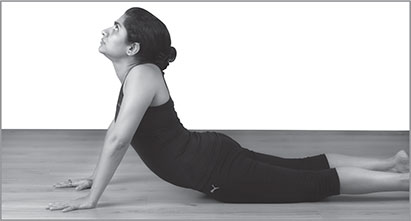
Wrong – Bhujangasana with over-arched back and sagging belly

Right – Bhujangaasana with toned back and belly in
A backbend should be done with the following points in mind:
- Stabilize the lower spine and the tail area by gently bringing tone in the hips (gluteal muscles).
- Pull your navel in towards your spine.
- Lift the middle and the upper back away from the pelvis.
- Do not push up through the palms to extend and lift the back. Note that safe versions of backbends require bent elbows. Overuse of arms should be discouraged. Instead, the palms should be used for minimal support as the movement is initiated by the upper back muscles.
Even when you perform poorna bhujangasana, which requires straight arms, make sure your lower back is long. If you feel a pinch in your lower back, stop the practice and perform the bhujangasana as described above.
Asanas without involving the core: During yoga practices, the activity of the inner corset or the deep abdominal muscles is fundamental to the stabilization of the posture. This central support makes it possible to release the compensatory tension we carry in different parts of the body. A weak, sagging and toneless abdomen strains the back. Any yoga practice, even a twist, should be initiated from the pelvis rather than the spine. Once we are able to enhance the TA sensation by slightly drawing in the lower abdomen, as mentioned on page 46 in chapter 6, we need to integrate this practice in all postures. To recall, the goal is to sustain a mild tone in the inner corset during any activity and the contraction should be just 10-25% of the maximum.
Therapeutic Practices for the Back
The best things in life are simple ones. Here I share some simple core exercises that have to be done with awareness for quick and sustained results. They have no side effects; only positive results. Enjoy them.
Imprinted Lower Back
Tones abdominal muscles
This is a very effective technique to do away with the pain caused by excessive lower back curvature. It is like wearing a natural belt around the lower back, except that it is made up of your own muscles. It gives the lower back the much needed support.
- Lie down flat on your back. Bend your legs at the knees, your heels at a comfortable distance from the hips.
- As you exhale, pull the navel in and press your lower back towards the mat.
- This will slightly lift the tail bone away from the floor and cause the pelvis to roll back towards the floor. This engages all the belt muscles.
- Breathe with your chest as you hold the position for five to ten seconds.
- Inhale to relax.
- Repeat as many times as you can in the morning and before you sleep at night. You will be pleasantly surprised to see the pain disappear!

Wrong – Over-arched back

Right – Imprinted lower back to tone the core
This is one of the tools to understand the correct pelvic alignment mentioned on page 105 in the previous chapter. The tilt in the pelvis observed in this practice should be applied when we stand or sit to keep it aligned.
Ardha-Pawanmuktasana (Half-Wind Release Pose or Half-Leg Lock Pose)
Stretches paraspinal muscles
- Lie down on your back with the legs bent.
- Imprint your back as explained in the previous practice.
- As you exhale, keep the abdominal muscles engaged and raise one leg.
- Hold the leg with your hands and press the thigh down towards the chest.
- The other thigh should not lift and should remain straight, pressed down.
- Tuck your chin to prevent over-arching of the neck.
- Hold for a minute even as you breathe continuously.
- Bring the folded leg down.
- Repeat on the other side.
- Repeat two more times on each side.

Ardha-Pawanmuktasana with one leg folded
Pawanmuktasana Roll (Roll in the Wind Release Pose)
Stretches the lower back
- Lie down. Take both legs in towards the chest.
- Imprint your back as explained before.
- Hold the legs with one palm on each shin (If you have sensitive knees, hold the thighs).
- Press your thighs in towards the chest.
- As you do that, make sure your tailbone is going towards the floor to create traction at the lower spine.
- Now roll from side to side to give the spine a nice massage.
- Continue as you breathe for 30 seconds.
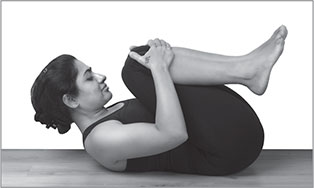
Pawanmuktasana roll
Setu Bandhasana with Pelvic Co-ordination (Bridge Pose)
Restores mobility at hips
- Lie down on the back. Keep the arms comfortably by the side of the hips. You can support your neck and head with a cushion or a rolled towel so that the forehead and the chin are at the same horizontal level.
- Bend your knees so that the feet are flat on the floor, parallel to each other.
- The knees too should be parallel to each other, pointing towards the ceiling.
- Imprint your back as described earlier.
- Maintaining the tone, lift the hips by about three to five inches. Make sure the abs do not jet out.
- Hold the pose as you take three breaths.
- Relax and settle back to the starting position.
- Repeat ten times.
When you press away from the floor, through the shins, the muscles and the connective tissues of the hips and the pelvis stretch, creating a better and deeper connection at the joints.
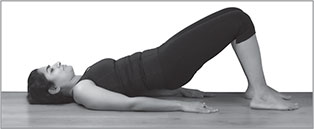
Setu Bandhasana with pelvic tilt
Single Leg Raises
This is the same practice prescribed for knees on page 88 in Chapter 10. Single leg raises also help strengthen the back muscles. If your lower back hurts, make sure you do them with the other leg bent.

Single leg raise with imprinted back
Side Leg Raises
This is the same practice as the one prescribed for knees on page 89 in Chapter 10. Side leg raises also help strengthen the back muscles. If your lower back hurts, make sure you do them with the lower leg bent.
Marjarasana Breaths on Chair (Cat Pose)
Warms up the spine's postural muscles
- Sit on a chair with a straight back. Make sure your head, neck and spine are in one line on top of each other.
- Place your palms on the knees.
- Through your arms, try to lengthen your back and lift the upper back. This will broaden the upper back and open up the chest. This action should not change the natural curvature of the lower back or overarch it.
- Pull the navel in by an inch or two, feeling the security of the core's support to the lower back.
- Inhale as you expand the chest.
- As you exhale, use the abdominal muscles to push your navel further in towards the lower back. Simultaneously, push the lower back behind, rounding it. This should curve your back into a C.
- Keep your core engaged all the while to prevent an overarched lower back.
- Then inhale to lift and expand the chest, keeping the core engaged.
- Repeat a few times smoothly in coordination with your breaths, without any jerks. It should be a slow, circular pattern to mobilize the back and warm up the muscles of the trunk.
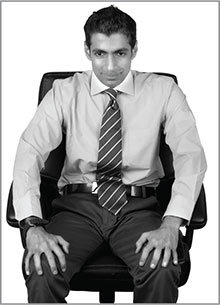
Marjarasana breaths on chair
Parvatasana with Wall Support (Mountain Pose with Wall Support)
Stretches the spine
- Stand facing the wall, about six inches away from it, with Tadasana leg alignments, as described on page 81, Chapter 10.
- Place your palms on the wall at waist level.
- Slowly start walking backward while keeping your palms rested on the wall. Walk till your torso and hands are parallel to the floor and the body has made a capital L with reference to the floor.
- Make sure your knees are not locked.
- Take five breaths. Each inhalation expands your chest and presses the four corners of your palm on the wall. Each exhalation takes your belly in and presses the three corners of the feet down on the floor.
- Hold for 30 seconds.
- To release, bend your knees, walk towards the wall and come up.
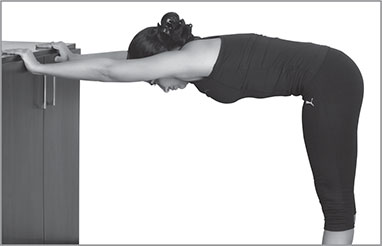
Parvatasana (half) with support
Ashwa Sanchalanasana (Equestrian Pose)
Stretches tight psoas muscles
- Stand with Tadasana leg alignments, as described on page 81, chapter 10.
- Take your right leg behind, toes pointing in front, as much as you can.
- Bring the right knee down.
- Flatten the right toes, such that all toe nails are pressing on the floor.
- Make sure your left knee is on top of your ankle. This is to safeguard the left knee. If the knee goes ahead of the ankle, use your hand to slide your foot forward. Do not bring the leg back to make this adjustment. Such an adjustment will beat the purpose of stretching the psoas muscle.
- Take your hips down as much as possible.
- Lift your torso up. Navel is, of course, pulled in with a gentle squeeze in the hips.
- Hold the posture for three breaths.
- To release, curl your right toes in, lift your knee up, lift your hips up and bring the leg forward. Slowly come up to a standing posture.
- Repeat on the other side.
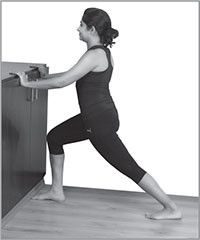
Ashwa sanchalanasana (psoas stretch)
Ardha Shalabhasana (Half Locust Pose)
Strengthens gluteal muscles
- Lie down on your stomach on a mat. Keep a thin folded blanket under the abdomen if there is lower back strain.
- Rest the forehead on the floor lengthening the neck, without pressing down on the nose.
- Let the hands rest by the side of the body.
- Prepare the body by connecting with your core. Make your legs firm and lengthen the tail bone region.
- Engage the buttock muscles without squeezing them too hard.
- Stretch the right leg, pointing the toes out.
- Lift the right leg straight up from the hip. The lift might not be too high.
- Make sure the right pelvic bone is still on the mat, the right hip pointing down.
- Hold the leg for three breaths.
- Slowly bring it down.
- Repeat on the other side.
- Repeat two more times on each side.

Ardha shalabhasana
Bhujanga-Shalabhasana (Cobra-Locust Pose)
Strengthens back muscles
Let us not get confused with the combination of names and focus instead on safely strengthening the back and the shoulder muscles.
- Lie down on your stomach on a mat. If there is lower back strain, keep a thin folded blanket under the abdomen.
- Rest the forehead on the floor, lengthening the neck, without pressing down on the nose.
- Let the hands rest by the side of the body.
- Prepare the body by connecting with your core. Make your legs firm and lengthen the tail bone region.
- Engage the buttock muscles without squeezing too hard.
- Take your navel in towards your spine.
- Lift the shoulders from the floor without raising the head or the hands from the floor. This is to engage your upper back. Feel the length you create on the sides of the body from your hips to your armpits.
- Inhale and lift the arms, the head and the legs a little off the ground. You will feel like you are extending out from the abs with the lift.
- Maintain this position for three breaths. Inhale as you expand your chest and exhale as you extend and lengthen your upper body and legs. Your breaths will help you feel light.
- Come down gently and relax.
- Repeat three times.

Bhujanga-Shalabhasana
Reverse Walking
Refer to page 157, Chapter 17.
Simple yogic asanas like the ones described in this chapter, when incorporated in our daily routine, ensure relief and protection from painful lower-back conditions.
Let us now move on to the third area of concern – the upper back-shoulder-neck region.